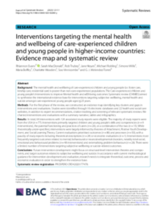Abstract:
Background
The mental health and wellbeing of care-experienced children and young people (i.e. foster care, kinship care, residential care) is poorer than non-care-experienced populations. The Care-experienced children and young people’s Interventions to improve Mental health and well-being outcomes Systematic review (CHIMES) aimed to synthesise the international evidence base for interventions targeting subjective wellbeing, mental health and suicide amongst care-experienced young people aged ≤ 25 years.
Methods
For the first phase of the review, the authors constructed an evidence map identifying key clusters and gaps in interventions and evaluations. Studies were identified through 16 electronic databases and 22 health and social care websites, in addition to expert recommendations, citation tracking and screening of relevant systematic reviews. They charted interventions and evaluations with a summary narrative, tables and infographics.
Results
In total, 64 interventions with 124 associated study reports were eligible. The majority of study reports were from the USA (n = 77). Interventions primarily targeted children and young people’s skills and competencies (n = 9 interventions), the parental functioning and practices of carers (n = 26), or a combination of the two (n = 15). While theoretically under-specified, interventions were largely informed by theories of Attachment, Positive Youth Development, and Social Learning Theory. Current evaluations prioritised outcomes (n = 86) and processes (n = 50), with a paucity of study reports including theoretical descriptions (n = 24) or economic evaluations (n = 1). Interventions most frequently targeted outcomes related to mental, behavioural or neurodevelopmental disorders, notably total social, emotional and behavioural problems (n = 48 interventions) and externalising problem behaviours (n = 26). There were a limited number of interventions targeting subjective wellbeing or suicide-related outcomes.
Conclusions
Future intervention development might focus on structural-level intervention theories and components, and target outcomes related to subjective wellbeing and suicide. In accordance with current methodological guidance for intervention development and evaluation, research needs to integrate theoretical, outcome, process and economic evaluation in order to strengthen the evidence base.

